You hear a lot about hydraulic pumps in this modern world. It would be virtually impossible to complete or create certain projects without a hydraulic pump and its accessories. These compact parts can force heavy objects into place with great precision and control. Hydraulic pumps are necessary for assembly equipment, construction machines, and farming devices. The hydraulic pump is at the heart of any system. In this article, we will answer the question “How does a hydraulic pump work?”. Read this new blog in Linquip to find out more.
We at Linquip offer you all of the information you need concerning hydraulic pump equipment, devices, and related products on our platform. We’re happy to assist you with any questions about hydraulic pumps that you may have. Please contact our experts today. The first thing we would recommend is that you take the time to read Linquip’s article, “Hydraulic Pumps: Working Principles, Function & Diagram.” Registering as a Linquip Expert will give you complete access to all of Linquip’s features.
Have you ever thought about submitting a Guest Post to Linquip? Guest posts are accepted on Linquip so you can do that too.
⇒ View a List of Hydraulic Pump for Sale and Their Suppliers ⇐
What is hydraulic pump?
A hydraulic pump which is the heart of a hydraulic system is a mechanical source of power that converts mechanical power into hydraulic energy (hydrostatic energy i.e. flow, pressure). It generates flow with enough power to overcome pressure induced by the load at the pump outlet. While mechanical rotational power is the product of torque and speed, hydraulic power is pressure times flow.
When a hydraulic pump operates, it creates a vacuum at the pump inlet, which forces liquid from the reservoir into the inlet line to the pump and by mechanical action delivers this liquid to the pump outlet and forces it into the hydraulic system.
All pumps may be classified as either positive-displacement or non-positive-displacement. Hydrostatic pumps are positive displacement pumps while hydrodynamic pumps can be fixed displacement pumps, in which the displacement (flow through the pump per rotation of the pump) cannot be adjusted, or variable displacement pumps, which have a more complicated construction that allows the displacement to be adjusted. Hydrodynamic pumps are more frequent in day-to-day life. Hydrostatic pumps of various types all work on the principle of Pascal’s law. Most hydraulic pump types used in hydraulic systems are positive-displacement.
Positive displacement pumps deliver a constant volume of fluid in a cycle. The discharge quantity per revolution is fixed in these pumps and they produce fluid flow proportional to their displacement and rotor speed. These pumps are used in most of the industrial fluid power applications. The output fluid flow is constant and is independent of the system pressure (load).
The important advantage associated with these pumps is that the high-pressure and low-pressure areas (means input and output region) are separated and hence the fluid cannot leak back due to higher pressure at the outlets. These features make the positive displacement pump most suited and universally accepted for hydraulic systems. The important advantages of positive displacement pumps over nonpositive displacement pumps include the capability to generate high pressures, high volumetric efficiency, and high power to weight ratio. The change in the efficiency of positive displacement pumps throughout the pressure range is small and the operating range of pressure and speed is wider.
How does a hydraulic pump work?
The working principle of hydraulic pump is the same for all the other pumps. Due to mechanical action, the pump creates a partial vacuum at the inlet. This causes the atmospheric pressure to force the fluid into the inlet of the pump. The pump then pushes the fluid into the hydraulic system. The pump contains two check valves. Check valve 1 is connected to the pump inlet and allows fluid to enter the pump only through it. Check valve 2 is connected to the pump discharge and allows fluid to exit only through it.
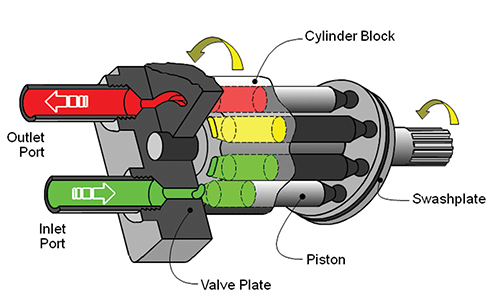
When the piston is pulled to the left, a partial vacuum is created in the pump cavity 3. This vacuum holds check valve 2 against its seat and allows atmospheric pressure to push the fluid inside the cylinder through check valve 1. When the piston is pushed to the right, the fluid movement closes check valve 1 and opens outlet valve 2. The quantity of fluid displaced by the piston is forcibly ejected from the cylinder. The volume of the fluid displaced by the piston during the discharge stroke is called the displacement volume of the pump.
The pumping action of a simple piston pump is shown in the figure below.
Hydraulic pump maintenance
The need for hydraulic preventive maintenance is determined over time by the operating conditions of the various hydraulic components. For example, a service interval of 10,000 hours (about 14 months) is generally recommended for piston pumps. Below is a list of daily maintenance tasks.
- Check oil levels in power unit tanks.
- Check for temperature changes in the oil.
- Check the system for water or dirt in the oil.
- Check for leaks.
- Check and tighten screws and pipe clamps.
- Verify pressure gauge readings.
- Monitor the running noise of the hydraulic oil pump, and electric motors to identify changes.
- Empty all valve panel drip pans.
- Check for possible leaks in valve groups by wiping an item clean before inspecting it.
- Keep surfaces of pipes, components, and tanks clean.
- Check with operators to determine if any service or maintenance is required.
- Check the service book to see if operators have recorded any problems.
Is A Hydraulic Pump Capable of Creating Pressure or Flow?
The pump creates liquid flow or movement and is not capable of creating pressure. A result of this is the production of the flow necessary to develop pressure, which depends on the resistance to fluid flow in the system.
Download Hydraulic Pump Working Principles PDF
Besides the post, we are also providing you with a PDF document, which you can save for future use as a reference whenever you need it. You can start downloading the PDF document from the link below.
So, now that you know the answer to the question ‘how does a hydraulic pump work?’, let us know what you think by leaving a reply in the comment section. We will be glad to have your viewpoint on the article. Is there any question we can help you through? Feel free to sign up on Linquip to get the most professional advice from our experts.
Buy Equipment or Ask for a Service
By using Linquip RFQ Service, you can expect to receive quotations from various suppliers across multiple industries and regions.
Click Here to Request a Quotation From Suppliers and Service Providers
Read More on Linquip
- Working Principles of Hydraulic Pump
- Difference Between Pump and Turbine
- Different Types of Hydraulic Pumps: a Complete Guide
- What Are Air Source Heat Pumps? A Complete Guide
- What is Hydraulic Pump: Learn The Basics, Boost Your Knowledge
- Pump Curve: All You Should Know About Definition and Read One
- 10 Parts of Hydraulic Pump + PDF & Function
- The 7 Best RV Water Pump In 2022 (Clear Guide + Review)
- The 10 Best Electric Air Pump in 2022 (Clear Guide)
- The Best HVAC Vacuum Pump in 2022 (Clear Guide)
- 9 Different Types of Rotary Pumps + PDF
- The 5 Best Well Pump in 2022 (Clear Guide)
- The 10 Best Condensate Pumps of 2022: A Complete Guide
- 13 Parts of Concrete Pump with Name & PDF
- 5 Types of Concrete Pumps + PDF
- 6 Type of Sump Pump and Which Are Better to Buy?
- 6 Parts of Pool Pump + Diagram & PDF
- 20 Parts of Submersible Pump + PDF
- What Is a Demand Pump and How Does It Work? (Clear Guide)
- 12 Parts of Sump Pump + Diagram

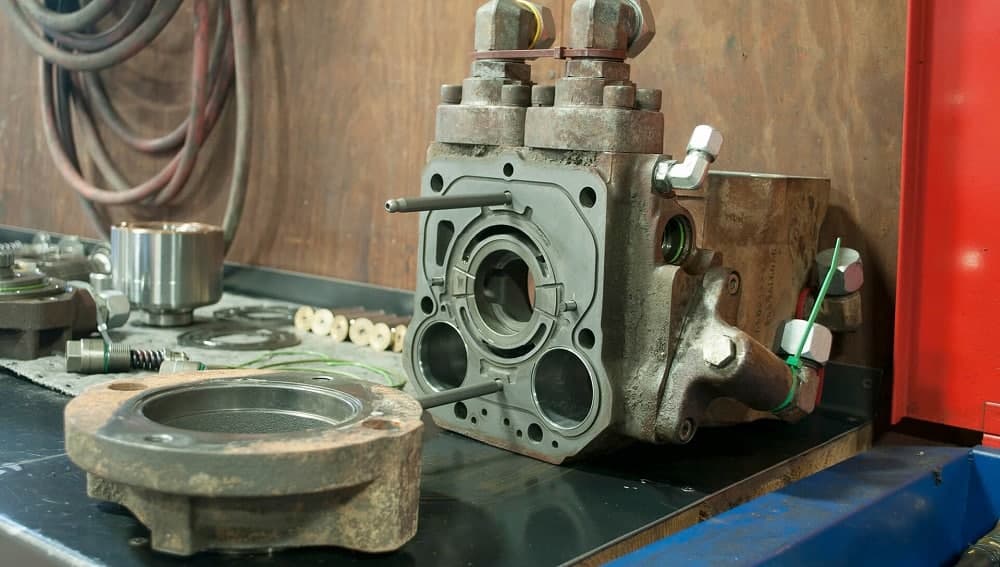
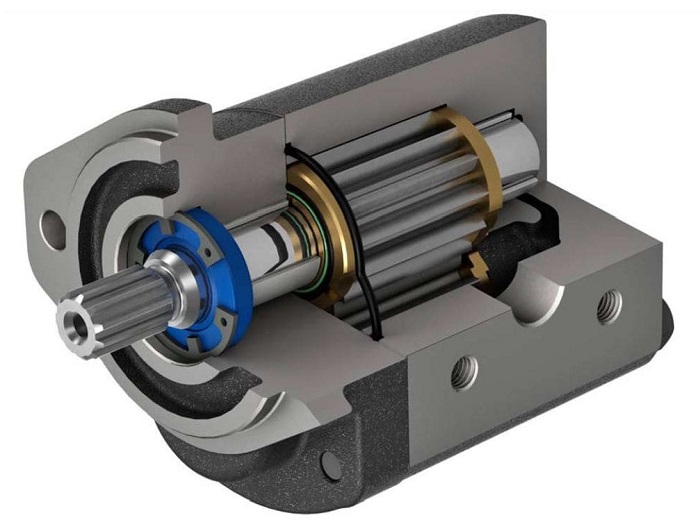
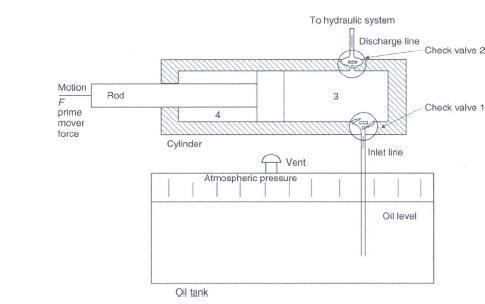
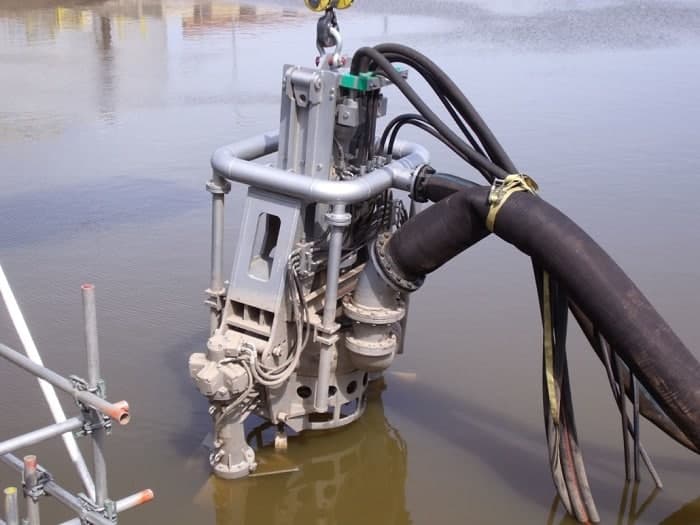


How long can a pump last if exposed to a continuous 247 working condition before maintenance?
Thanks for visiting our website, Godwin! Bearings should generally be oiled for grease-lubricated pumps every three months or 2,000 operating hours, whichever comes first.